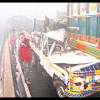Speed limit set for all types of vehicles

The speed limit for cars, buses, and minibuses on expressways would be 80km per hour, while it would be 60kmph for motorcycles and 50kmph for trucks.
Bikes and trucks can run inside city corporations, municipalities, and district towns at a maximum speed of 30kmph which would be 40kmph for other vehicles.
If anyone violates the speed limit, they will have to face punitive actions under the Road Transport Act-2018. Violators will face up to three months' jail or a fine of Tk 10,000 or both, says the act.
These are some of the provisions of the Motor Vehicle Speed Limit Guideline-2024, which the BRTA for the first time issued to reduce road crashes.
The Road Transport and Highways Division on Sunday approved the guideline.
This guideline, which sets different speed limits for different types of roads and vehicles, will come in force from today, Nur Mohammad Mazumder, chairman of Bangladesh Road Transport Authority (BRTA), told The Daily Star last night.
Speeding and reckless driving are considered major reasons behind road crashes, but there had been no guideline for speed limits on highways and roads.
Different government agencies -- which are constructing roads -- are setting different speed limits for similar kinds of roads, confusing drivers.
The number of speedy vehicles -- passenger and goods-laden ones -- have increased manyfold with the expansion of the country's road network and thus road crashes are frequent, reads the preamble of the guideline.
BRTA, under the Road Transport Act-2018 and its rules, issued the guideline to halve road deaths by 2030, which is a Sustainable Development Goals (SDG) .
SPEED LIMIT
As per the guideline, the maximum speed for buses, minibuses, and cars, SUVs, microbuses, and other light vehicles would be 80kmph on expressways.
This limit for trucks, small trucks, and other goods-laden vehicles would be 50kmph and it would be 60kmph for bikes and 50kmph for articulated lorries, it reads.
Three-wheelers would not be allowed on expressways and national highways, the guideline mentions.
Cars, SUVs, microbuses, buses, minibuses, and other light vehicles can operate on the national highways (category A) at a maximum speed of 80kmph.
The limit would be 50kmph for trucks, bikes, and articulated lorries on such highways.
It would be 70kmph for cars, buses, and minibuses on the national highways (category B), 50kmph for bikes, and 45kmph for trucks and articulated lorries on the highways.
The limit would be 60kmph for cars, buses, and minibuses on district roads while it would be 50kmph for bikes and 45km for trucks and articulated lorries.
The maximum speed limit would be 40kmph for cars, buses, and minibuses on streets inside city corporations, municipalities, and district towns, and 30kmph for trucks, motorcycles, and articulated lorries.
The guideline also determines speed limits for roads in upazilas and villages.
The local administrations will fix the speed limit near educational institutions, religious establishments, hospitals, markets, and residential areas. However, it would not be over 40kmph on national highways and 30kmph on regional highways.
This rule would not be applicable for vehicles providing emergency services like ambulances and fire engines, the guideline reads.
IMPLEMENTATION
The government banned operation of three-wheelers on 22 important highways in August 2015, but it could not be implemented fully.
Asked how the authority will implement the speed limit across the country, BRTA Chairman Nur said the implementing agencies of road projects will set up necessary signs containing the speed limit along the roads.
The law enforcers will take action against the violators, he said, adding that everyone, including drivers and road users, has the responsibility to implement it.

 For all latest news, follow The Daily Star's Google News channel.
For all latest news, follow The Daily Star's Google News channel. 









Comments